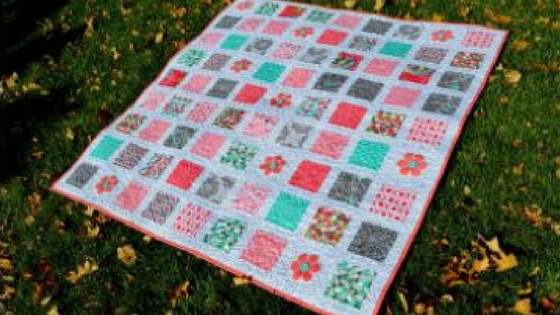YOU WILL NEED:
One 10″ Stacker or (4) 5″ Stackers of The Cottage Garden
1 Yard of a matching solid for the Applique and Binding – I used the color Shell
2 Yards of Cottage Newsprint Grey for the background
4 Yards of your choice of Backing fabric
STEP 1 – CUTTING
If you are using a 10″ stacker, subcut (18) 10″ squares into (4) 5″ squares for a total of (72) 5″ squares. Â If you are using 5″ stackers simply choose out (72) 5″ squares.
From your 1 yard of applique and binding fabric cut (6) 2 1/2″ x width of fabric strips for binding and (9) 6″ x 6″ squares for the applique.
From your 2 yards of background fabric cut
(6) 2″ x width of fabric strips
(30) 2″ x 17″ rectangles
(54) 2″ x 5″ rectangles
(9) 5 ” x 5″ rectangles
This is where chain stitching will save you a lot of time. So once you have sewn one rectangle onto the square, don’t stop. Just keep feeding more sets through the machine until you have stitched all 54 sets. And you don’t have to count them, just keep going until you run out of background rectangles 😉
Now, layout 2 pieced squares and one final square as shown below. This will be your row. Place the second pieced square onto the first with right sides together and stitch a 1/4″ seam along the edge. Then place the square onto the pieced row with right sides together and sew a 1/4″ seam along the edge. (Once again, chain stitching here will save you a ton a time!!!) Press the seams outwards to the squares. Make a total of 27 rows.
STEP 3 – MAKING THE BLOCKS
And now with the rows sewn, you are read to sew the block together. Place 3 rows and 2 background 2″ x 17″ rectangles out as shown below. Take care that you only have one row that includes a blank background square in it.
Place the sashing strips onto the center row with right sides together as shown. Stitch a 1/4″ seam along the edge aligning as you go.
Press the seam allowances outwards to the sashing strips.
Now place the top and bottom row onto the pieced center with right sides together. Sew a 1/4″ seam along each edge aligning as you go.
Press the seam allowances inwards to the sashing strips. And your block is done.
Now simply repeat this step to make a total of 9 blocks. I sewed one block at a time, arranging each block so the the background square was in a different placement in each block.
STEP 4 – ADDING THE APPLIQUE
And now you are ready to add a little applique fun to your finished blocks. This will be just a quick overview of the process, but if you are new to applique and would like more explanation you can see my 2 part video series on applique here 😉 Adhere a 6″ x 6″ square of fusible webbing to the back of your (9) 6″ x 6″ using the manufactures directions. (And yes, if it says use a dry iron, you really want to use a dry iron 🙂
Save and print the following image to use as a template for your flowers, or if you have a different flower shape you prefer, just print it off at about 3 1/2 to 4″ big 😉

Cut out your template and then trace it onto the paper side of your fusible web. Now simple cut out on the lines and then remove the paper backing from your applique. Repeat to make 9 applique flowers.
Using the manufactures settings, adhere your applique to the center of your background fabric square. Then use your favorite stitch to stay stitch the applique in place. I used a blanket stitch, but other popular stitches would be a straight or zig-zag stitch 😉
Adhere and stitch all 9 appliques on your blocks, one applique per block 😉 And you are ready to move on.
STEP 5 – MAKING THE QUILT TOP
This is where it all starts coming together. Layout your 9 blocks, playing with the position of your colors and applique until it is pleasing to the eye. I like to snap a picture at this point so I can refer back to it if I accidentally get my rows or blocks mixed up. Place a 2″ x 17″ rectangle around the blocks the sides of the blocks as shown below.
Place the sashing rectangles onto the blocks with right sides together. Stitch a 1/4″ seam along the edges, aligning as you go. I like to stack these all up and take them to my machine at once, but again, you will want that picture to refer back to when it is time to lay them out again 😉
Press the seams towards the sashing and lay your blocks back out in rows.
Now you are ready to sew the rows. Place the second sashed block onto the first with right sides together. Sew a 1/4″ seam along the edge aligning as you go. Then place the third sashed block onto the now pieced first and second sashed block with right sides together. Sew a 1/4″ seam along the edge aligning as you go. Repeat for all 3 rows. Press the seam allowances towards the sashing.
Now, you just have to add the horizontal sashing. Grab your 6 width of fabric background strips. Sew them together end to end and press the seams to the side. Cut the long strip into (4) 57″ strips. I like to just lay them between my rows and then cut them about 1 1/2″ longer.
Place the background sashing row onto the pieced rows with right sides together. Stitch a 1/4″ seam along the edges, aligning as you go.
When you get to the end of the row, trim the sashing even with the pieced row.
Press the seams towards the sashing strips. Almost done!!!
Place the second row onto the first with right sides together. Align and pin each of the rows. They won’t match up along the pinned edge because of the sashing, but just take care they are aligned. Sew a 1/4″ seam along the pinned edge.
Now. place the top row onto the now pieced second and third row with right sides together. Once again, align and pin each of the sashing rows. Sew a 1/4″ seam along the pinned edge. Now simply press the seams towards the long sashing rows.
And just like that, your quilt top is done!!! Isn’t it just so cute!!!
Then, if you like, you can add a button to the center of each of your flower appliques for that extra little touch of cuteness. I used Riley Blake’s teal 1″ Stitched Button. You can sew these on by hand or use your machine, whichever you prefer 😉

